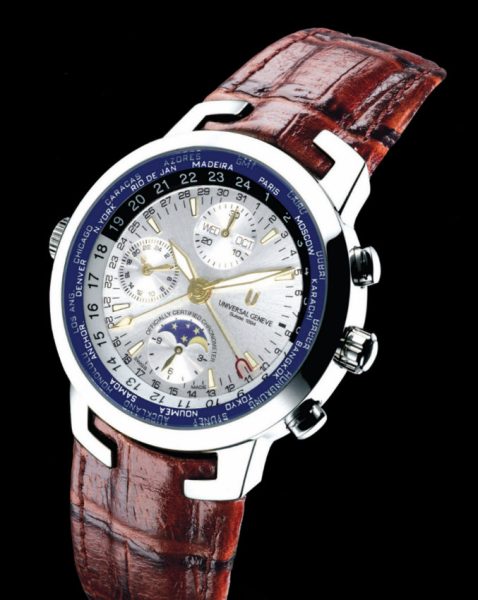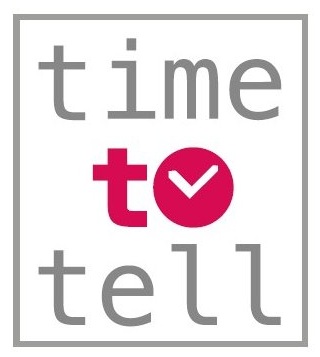26 January 2024
- Universal chronographs
The first Universal pocket chronographs were usually fitted with Le Phare calibers, the famous Le Locle manufacturer that supplied many other companies. Gradually, Martel calibers came into use, particularly for wrist chronographs, but Jeanneret-Lémania calibers were also available.


Universal chronograph, c. 1920, Martel calibre


Universal chronograph, c. 1920, Jeanneret/Lémania calibre
Note the 2 coupling systems, horizontal for the chronograph seconds, oscillating pinion for the chronograph minutes
From 1934, when Universal specialized in chronographs, all chronographs adopted the second pusher. This development took place in two stages, the very first versions having two column wheels, then a single one. The minute counter is a 45-minute counter, whereas most other chronographs of the time had a 30-minute counter. The Compur trademark, registered in 1934, is often added to the dial. Multiple scales may appear on the dials: telemeter, tachometer, pulsometer (graduated for 30 pulses).
2.1 The main chronograph models
(the dates of the illustrations are those of the publication years of the documents, and are not necessarily the release dates of the models)
– 1934: Compur model, 2 pushers and 45-minute counter.

Compur, c. 1934
– 1936: Colonial model. A chronograph “protected against the elements, humidity, snow, sand, dust, etc.”. This was the first attempt at a waterproof chronograph.

Colonial, 1936
– 1937: chronograph calibers of different sizes are attested: 12 and 14.5 lines. Second version of the Colonial model with a more conventional case. Contax chronograph, prototype of the Compax

Colonial, 1937
– 1938: registration of the Compax trademark, and release the same year of the Compax model with hour counter, at the request of Hermès in Paris.

Compax, 1938
– 1940: registration of the Aero-Compax trademark, launch of the Aero-Compax chronograph with a second independent dial for memorizing an hour. Launch of square chronographs with a small 10.5-line caliber. Launch of pocket chronographs with Compur and Compax calibers.

Aero-Compax, 1940

Onboard chronograph, 1941

Square chronograph, 1940
– 1941: first chronographs with waterproof case and round push-buttons

Waterproof watches and chronographs, 1941
– circa 1942: Dato-Compax model with date hand at noon

Dato-Compax
– 1943: registration of the Bi-Compax and Tri-Compax trademarks. Presentation of the Tri-Compax chronograph, officially launched in 1944 for the company’s 50th anniversary. It is a chronograph with full calendar (date, day and month) and moon phases. The flagship of Universal’s chronograph range, it was an international success.

Tri-Compax, 1944
– 1944: registration of the Uni-Compax trademark, which replaces the Compur trademark on dials.

Uni-Compax
– 1948: registration of the Medico-Compax trademark, and launch of the Medico-Compax model featuring a pulsometric scale based on 15 beats. Presentation of a split-seconds (rattrapante)chronograph, with or without hour counter.

Medico-Compax

Chronograph rattrapante, 1948
– 1951: registration of the Flight-Compax trademark
– 1962 (?): waterproof version of Tri-Compax

waterproof version of Tri-Compax, 1965
– 1964 (?): waterproof Compax version with rotating bezel

waterproof Compax version with rotating bezel, 1964
– 1967: registration of the Space-Compax trademark, launch of the Space-Compax diver’s chronograph with asymmetrical waterproof case, screwed push-buttons protected by a replaceable cap.

Space-Compax, 1967
– 1968: launch of a new version of the Aero-Compax chronograph with 24-hour dial and rotating bezel.

Aero-Compax, c. 1968
– 1988 : launch of a range of automatic chronographs based on the Valjoux 7750, the first automatic Universal chronographs.

Universal automatic chronographs, 1989
– 1991 : new Compax models, Valjoux base

Compax, 1991
– 1992: Compax 1950, inspired by models from the 1950s, Lemania calibres

Compax « 1950 », 1992
– 1995: chronograph model Golden Master Tech with rattrapante and power reserve, Valjoux base, 100 pieces in gold, 500 pieces in steel

Golden Master Tech, 1995
– 1996: Golden Chronotech, base V. 7750, Golden Complitech, calibre Valjoux 7751 with calendar and moon phases, and Lémania calibres for Golden Compax chronographs.

Golden Chronotech, 1997

Golden Complitech, 1996

Golden Compax, 1996
– 1997: Ayrton Senna chronograph models, with mechanical and quartz calibres, Lémania calibre chronographs, automatic chronographs based on Valjoux 7750 Golden Chronotech and Golden Classic Chronometer chronographs.

Ayrton Senna, 1997
– 1998: Compax screw-on pushers, Lémania base

Compax, 1998
– 1999: reissue of the Aero-Compax chronograph with 24-hour dial and bezel, screwed push-buttons

Aero-Compax, 1999
– 2001: launch of Compax Vortex Quartz and Compax Cirrus quartz chronographs.

Compax Vortex, 2001

Compax Cirrus, 2002
– 2003: launch of the Aero Tri-Compax chronograph, based on Valjoux 7751, and the Polar Compax chronograph, based on Valjoux 7750.

Aero-Tricompax, 2003

Polar Compax, 2003
– 2006: launch of Okeanos Aero-Compax, Lemania base

Okeanos Aero-Compax, 2006
2.2 Manufacture chronograph calibres
1939


1949




Notes:
About Time To Tell: Time To Tell has one of the largest private digitized databases on the history of Swiss watchmaking, with over 2.3 TB of data on more than 1,000 Swiss watch manufacturers. This database has been built up over a period of some thirty years, and continues to be fed with around 50 to 100 GB of data every year. The database is made up of old documents, mostly Swiss trade magazines, dating from the late 19th to the late 20th century. Most of these documents are not available on the Internet. Historical articles published on time2tell.com always cite the sources used.
Time To Tell is a private company, independent of any watch manufacturer.
Concerning Universal Genève: Most online information about Universal has no credible sources. As a result, false information is repeated from site to site. This is the case, for example, with the release dates of the various Universal chronograph models or the origin of certain watches such as the Autorem. This article on Universal has taken several months to complete and is based solely on reliable historical sources. All sources used are referenced. However, this does not preclude errors or omissions. Any comments are welcome, and readers can contact us at timetotell@orange.fr
©Time To Tell, 2024
Reproduction forbidden without authorization. Any use of this article by an artificial intelligence is strictly forbidden and will be considered as copyright infringement.
